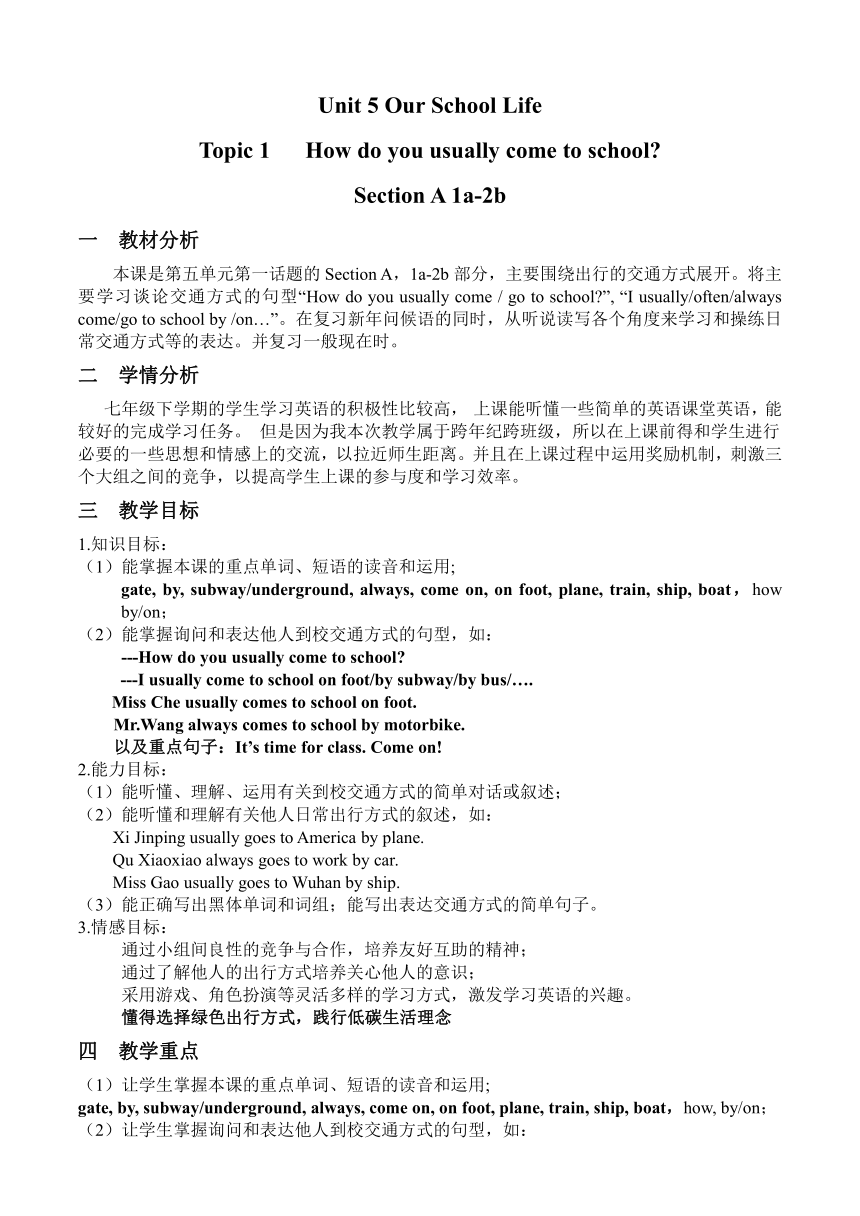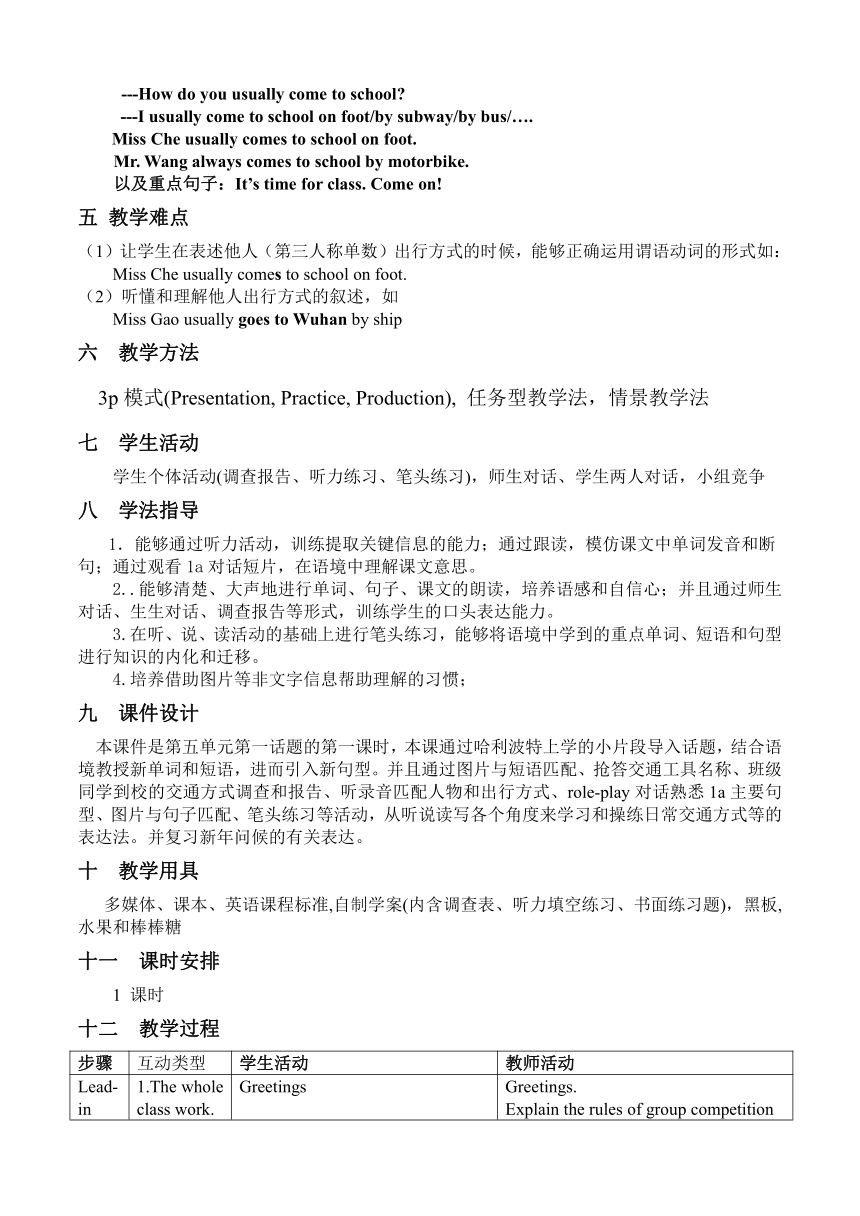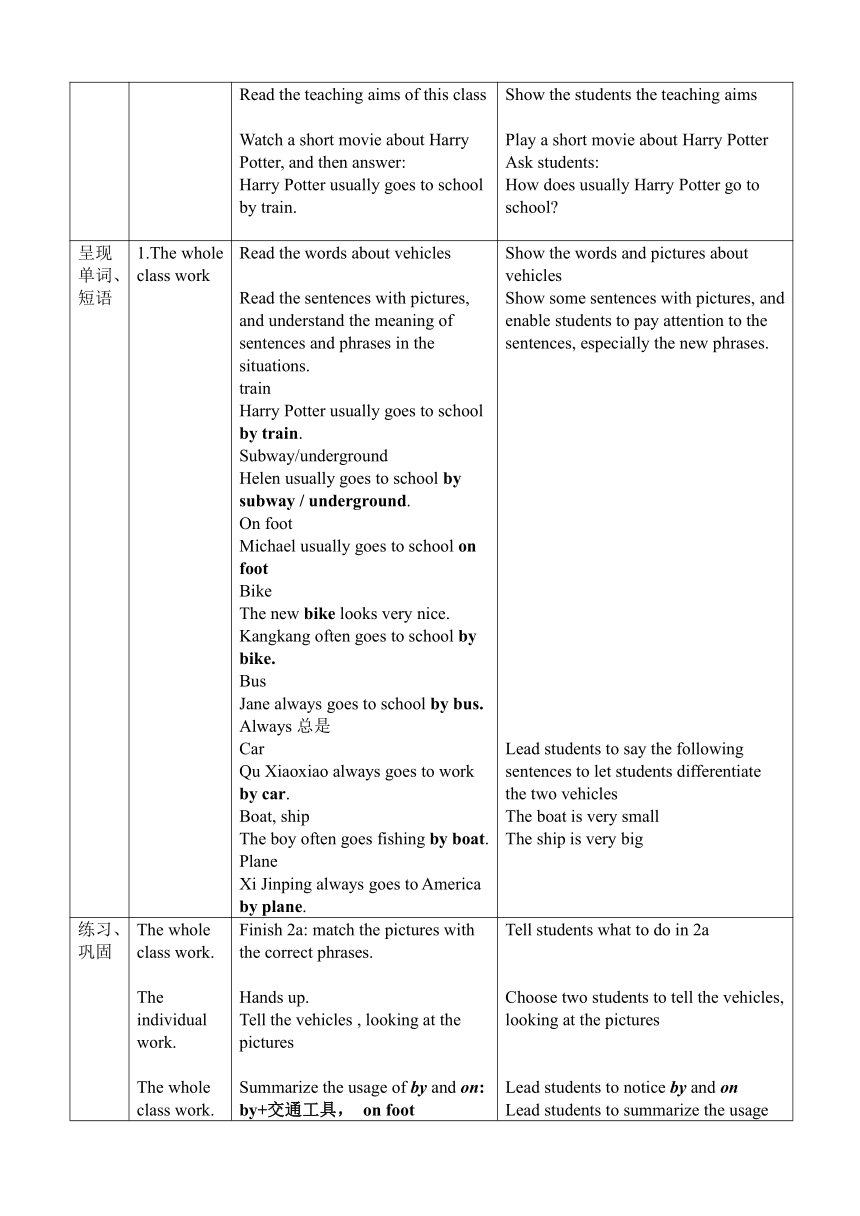仁爱科普版七年级下册 Unit5 Our school life Topic 1 SectionA 教案(表格式)
文档属性
| 名称 | 仁爱科普版七年级下册 Unit5 Our school life Topic 1 SectionA 教案(表格式) |  | |
| 格式 | doc | ||
| 文件大小 | 106.5KB | ||
| 资源类型 | 教案 | ||
| 版本资源 | 仁爱科普版 | ||
| 科目 | 英语 | ||
| 更新时间 | 2023-03-21 18:58:21 | ||
图片预览



文档简介
Unit 5 Our School Life
Topic 1 How do you usually come to school
Section A 1a-2b
一 教材分析
本课是第五单元第一话题的Section A,1a-2b部分,主要围绕出行的交通方式展开。将主要学习谈论交通方式的句型“How do you usually come / go to school ”, “I usually/often/always come/go to school by /on…”。在复习新年问候语的同时,从听说读写各个角度来学习和操练日常交通方式等的表达。并复习一般现在时。
二 学情分析
七年级下学期的学生学习英语的积极性比较高, 上课能听懂一些简单的英语课堂英语,能较好的完成学习任务。 但是因为我本次教学属于跨年纪跨班级,所以在上课前得和学生进行必要的一些思想和情感上的交流,以拉近师生距离。并且在上课过程中运用奖励机制,刺激三个大组之间的竞争,以提高学生上课的参与度和学习效率。
三 教学目标
1.知识目标:
(1)能掌握本课的重点单词、短语的读音和运用;
gate, by, subway/underground, always, come on, on foot, plane, train, ship, boat,how by/on;
(2)能掌握询问和表达他人到校交通方式的句型,如:
---How do you usually come to school
---I usually come to school on foot/by subway/by bus/….
Miss Che usually comes to school on foot.
Mr.Wang always comes to school by motorbike.
以及重点句子:It’s time for e on!
2.能力目标:
(1)能听懂、理解、运用有关到校交通方式的简单对话或叙述;
(2)能听懂和理解有关他人日常出行方式的叙述,如:
Xi Jinping usually goes to America by plane.
Qu Xiaoxiao always goes to work by car.
Miss Gao usually goes to Wuhan by ship.
(3)能正确写出黑体单词和词组;能写出表达交通方式的简单句子。
3.情感目标:
通过小组间良性的竞争与合作,培养友好互助的精神;
通过了解他人的出行方式培养关心他人的意识;
采用游戏、角色扮演等灵活多样的学习方式,激发学习英语的兴趣。
懂得选择绿色出行方式,践行低碳生活理念
四 教学重点
(1)让学生掌握本课的重点单词、短语的读音和运用;
gate, by, subway/underground, always, come on, on foot, plane, train, ship, boat,how, by/on;
(2)让学生掌握询问和表达他人到校交通方式的句型,如:
---How do you usually come to school
---I usually come to school on foot/by subway/by bus/….
Miss Che usually comes to school on foot.
Mr. Wang always comes to school by motorbike.
以及重点句子:It’s time for e on!
五 教学难点
(1)让学生在表述他人(第三人称单数)出行方式的时候,能够正确运用谓语动词的形式如:
Miss Che usually comes to school on foot.
(2)听懂和理解他人出行方式的叙述,如
Miss Gao usually goes to Wuhan by ship
六 教学方法
3p模式(Presentation, Practice, Production), 任务型教学法,情景教学法
七 学生活动
学生个体活动(调查报告、听力练习、笔头练习),师生对话、学生两人对话,小组竞争
八 学法指导
1.能够通过听力活动,训练提取关键信息的能力;通过跟读,模仿课文中单词发音和断句;通过观看1a对话短片,在语境中理解课文意思。
2..能够清楚、大声地进行单词、句子、课文的朗读,培养语感和自信心;并且通过师生对话、生生对话、调查报告等形式,训练学生的口头表达能力。
3.在听、说、读活动的基础上进行笔头练习,能够将语境中学到的重点单词、短语和句型进行知识的内化和迁移。
4.培养借助图片等非文字信息帮助理解的习惯;
九 课件设计
本课件是第五单元第一话题的第一课时,本课通过哈利波特上学的小片段导入话题,结合语境教授新单词和短语,进而引入新句型。并且通过图片与短语匹配、抢答交通工具名称、班级同学到校的交通方式调查和报告、听录音匹配人物和出行方式、role-play对话熟悉1a主要句型、图片与句子匹配、笔头练习等活动,从听说读写各个角度来学习和操练日常交通方式等的表达法。并复习新年问候的有关表达。
十 教学用具
多媒体、课本、英语课程标准,自制学案(内含调查表、听力填空练习、书面练习题),黑板,水果和棒棒糖
十一 课时安排
1 课时
十二 教学过程
步骤 互动类型 学生活动 教师活动
Lead-in 1.The whole class work. GreetingsRead the teaching aims of this classWatch a short movie about Harry Potter, and then answer:Harry Potter usually goes to school by train. Greetings. Explain the rules of group competitionShow the students the teaching aimsPlay a short movie about Harry PotterAsk students:How does usually Harry Potter go to school
呈现单词、短语 1.The whole class work Read the words about vehiclesRead the sentences with pictures, and understand the meaning of sentences and phrases in the situations.trainHarry Potter usually goes to school by train.Subway/undergroundHelen usually goes to school by subway / underground.On footMichael usually goes to school on footBikeThe new bike looks very nice.Kangkang often goes to school by bike.BusJane always goes to school by bus.Always总是CarQu Xiaoxiao always goes to work by car.Boat, shipThe boy often goes fishing by boat.PlaneXi Jinping always goes to America by plane. Show the words and pictures about vehiclesShow some sentences with pictures, and enable students to pay attention to the sentences, especially the new phrases.Lead students to say the following sentences to let students differentiate the two vehiclesThe boat is very smallThe ship is very big
练习、巩固 The whole class work.The individual work.The whole class work.The individual work. Finish 2a: match the pictures with the correct phrases.Hands up. Tell the vehicles , looking at the picturesSummarize the usage of by and on:by+交通工具, on footHands up.Say the vehicles loudly Tell students what to do in 2aChoose two students to tell the vehicles, looking at the picturesLead students to notice by and onLead students to summarize the usageTell students the rules of the quick-answer game. Show pictures of vehicles one by one, and choose some students to answer.
呈现句型 The whole class work the individual work. Listen to the teacher, imitate and acquire the new sentence structuresAnswer with sentence pattern:I usually come to school on/by… Present the sentence: I usually come to school by electric motorbike.Ask students this question, and repeatHow do you usually come to school
口语练习、巩固 Pair workand group workPair work individual work Do a survey in class: ask 3 students with the following sentence pattern:A: How do you usually come to school B: I usually come to school by / on….Then fill in the survey form.Talk with the partner about theresults of the survey, imitating theteacher’s survey report.Tell the classmates and the teacher own survey report Give students the Learning Plan with survey forms and sentence patterns on.Tell students what to do in a survey, and how to do that.Show students the teacher’s own survey results:nameThe way(方式) to schoolQiu ZujieOn footMr. WangBy motorbikeMiss CheOn footAnd present the survey report to them:Qiu Zujie usually comes to school on foot.Mr. Wang usually comes to school by motorbike.Miss Che usually comes to school on foot.Enable students pay attention to comesChoose three or four students to do survey reports.
听力练习、巩固 The whole class work and theindividual work The whole class work and theindividual work Finished 2b:Listen and match the means of transportation in 2a with the people.Tell the classmates answersMr. Zhang _______Kangkang ______ Ms. Black ________Jane’s uncle_______Miss Gao ______Ellen _______Zhao Lin _________Mr. Brown__________Wu Hui_______Listen to 1a and fill in the blanks:Kangkang often comes toschool_________.2. Helen usually comes to school___________.3. Jane always comes to school_______.Tell the answers Tell students what to do in 2bPlay the listening record twiceCheck answers by asking one studentLet students find this part in the Learning Plan.Play the listening record twice.Ask 3 students to answer
呈现 The whole class work Watch the flashListen, look and understandThen listen again, follow andunderstand Play a flash of 1a. Tell students to listen, look and understand.Play the listening record of 1a. let students listen, follow and understand.
口语练习、巩固 The whole class workThe pairworkThe pairwork Listen to the teacher’s conversation with a student.Practice the conversation ,following the example:A: Hi,……! Happy New Year!B: The same to you. Nice to see you again,……A: Nice you see you, too.B: How do you usually come to school A: I usually come to school…..... How about you, ………. B: I usually come to school…A: Oh, it’s time for e on!Perform the conversations Give students a situation:Suppose you meet your classmates at the school gate. Have a talk with him/her.Perform the conversation with a student as an example.Give suitable assessment and encouragement.
情感教育 theindividual work The whole class workThe whole class work Finish 1b:Read the sentences and choose the correct one for each picture.Look through the students’ ways to school again.Learn that they have green travel.Read the introduction about green travel:在条件许可的情况下,尽可能地采取耗能低、排碳少的出行方式,比如乘坐公共交通工具、开节能环保车、拼车(指几个人合乘一辆车)、骑自行车乃至步行等,减少因出行产生的碳排放 ( http: / / baike. / lemma / ShowInnerLink.htm lemmaId=387254&ss_c=ssc.citiao.link )量,即绿色出行Chant after the teacherGreen travel! Love the earth! Tell students what to do with 1bAsk one student to tell the answers.Lead students to notice the ways to school in 1b. And tell students they all have green travel.Show students what the green travel is.Lead students to chant:Green travel! Love the earth!
产出 theindividual work The whole class work Do the exercise in this partSeveral students will be chosen to write down their answers on a small blackboard.Correct the mistakes of the answers on the small blackboard. Let students find this part on the Learning Plan.三、Production产出(填空和翻译)1.—Happy New Year! —___________/____________.2. Your new bike________ ______ _______(看起来很漂亮) 3. .—______ you often come to school ______ train — Yes, I do.4.—_______ do you usually come to school — I usually come to school ______foot.5. It’s time e ______!6. --- How_____Miss Che come to school --- She often______to school on foot.7. 简总是坐公交车去学校。_______________________________.
on foot
by motorbike
on foot
A. by subway
B. by bike
C. by plane
D. on foot
E. by car
F. by train
G. by ship
H. by bus
I. by boat
PAGE
Topic 1 How do you usually come to school
Section A 1a-2b
一 教材分析
本课是第五单元第一话题的Section A,1a-2b部分,主要围绕出行的交通方式展开。将主要学习谈论交通方式的句型“How do you usually come / go to school ”, “I usually/often/always come/go to school by /on…”。在复习新年问候语的同时,从听说读写各个角度来学习和操练日常交通方式等的表达。并复习一般现在时。
二 学情分析
七年级下学期的学生学习英语的积极性比较高, 上课能听懂一些简单的英语课堂英语,能较好的完成学习任务。 但是因为我本次教学属于跨年纪跨班级,所以在上课前得和学生进行必要的一些思想和情感上的交流,以拉近师生距离。并且在上课过程中运用奖励机制,刺激三个大组之间的竞争,以提高学生上课的参与度和学习效率。
三 教学目标
1.知识目标:
(1)能掌握本课的重点单词、短语的读音和运用;
gate, by, subway/underground, always, come on, on foot, plane, train, ship, boat,how by/on;
(2)能掌握询问和表达他人到校交通方式的句型,如:
---How do you usually come to school
---I usually come to school on foot/by subway/by bus/….
Miss Che usually comes to school on foot.
Mr.Wang always comes to school by motorbike.
以及重点句子:It’s time for e on!
2.能力目标:
(1)能听懂、理解、运用有关到校交通方式的简单对话或叙述;
(2)能听懂和理解有关他人日常出行方式的叙述,如:
Xi Jinping usually goes to America by plane.
Qu Xiaoxiao always goes to work by car.
Miss Gao usually goes to Wuhan by ship.
(3)能正确写出黑体单词和词组;能写出表达交通方式的简单句子。
3.情感目标:
通过小组间良性的竞争与合作,培养友好互助的精神;
通过了解他人的出行方式培养关心他人的意识;
采用游戏、角色扮演等灵活多样的学习方式,激发学习英语的兴趣。
懂得选择绿色出行方式,践行低碳生活理念
四 教学重点
(1)让学生掌握本课的重点单词、短语的读音和运用;
gate, by, subway/underground, always, come on, on foot, plane, train, ship, boat,how, by/on;
(2)让学生掌握询问和表达他人到校交通方式的句型,如:
---How do you usually come to school
---I usually come to school on foot/by subway/by bus/….
Miss Che usually comes to school on foot.
Mr. Wang always comes to school by motorbike.
以及重点句子:It’s time for e on!
五 教学难点
(1)让学生在表述他人(第三人称单数)出行方式的时候,能够正确运用谓语动词的形式如:
Miss Che usually comes to school on foot.
(2)听懂和理解他人出行方式的叙述,如
Miss Gao usually goes to Wuhan by ship
六 教学方法
3p模式(Presentation, Practice, Production), 任务型教学法,情景教学法
七 学生活动
学生个体活动(调查报告、听力练习、笔头练习),师生对话、学生两人对话,小组竞争
八 学法指导
1.能够通过听力活动,训练提取关键信息的能力;通过跟读,模仿课文中单词发音和断句;通过观看1a对话短片,在语境中理解课文意思。
2..能够清楚、大声地进行单词、句子、课文的朗读,培养语感和自信心;并且通过师生对话、生生对话、调查报告等形式,训练学生的口头表达能力。
3.在听、说、读活动的基础上进行笔头练习,能够将语境中学到的重点单词、短语和句型进行知识的内化和迁移。
4.培养借助图片等非文字信息帮助理解的习惯;
九 课件设计
本课件是第五单元第一话题的第一课时,本课通过哈利波特上学的小片段导入话题,结合语境教授新单词和短语,进而引入新句型。并且通过图片与短语匹配、抢答交通工具名称、班级同学到校的交通方式调查和报告、听录音匹配人物和出行方式、role-play对话熟悉1a主要句型、图片与句子匹配、笔头练习等活动,从听说读写各个角度来学习和操练日常交通方式等的表达法。并复习新年问候的有关表达。
十 教学用具
多媒体、课本、英语课程标准,自制学案(内含调查表、听力填空练习、书面练习题),黑板,水果和棒棒糖
十一 课时安排
1 课时
十二 教学过程
步骤 互动类型 学生活动 教师活动
Lead-in 1.The whole class work. GreetingsRead the teaching aims of this classWatch a short movie about Harry Potter, and then answer:Harry Potter usually goes to school by train. Greetings. Explain the rules of group competitionShow the students the teaching aimsPlay a short movie about Harry PotterAsk students:How does usually Harry Potter go to school
呈现单词、短语 1.The whole class work Read the words about vehiclesRead the sentences with pictures, and understand the meaning of sentences and phrases in the situations.trainHarry Potter usually goes to school by train.Subway/undergroundHelen usually goes to school by subway / underground.On footMichael usually goes to school on footBikeThe new bike looks very nice.Kangkang often goes to school by bike.BusJane always goes to school by bus.Always总是CarQu Xiaoxiao always goes to work by car.Boat, shipThe boy often goes fishing by boat.PlaneXi Jinping always goes to America by plane. Show the words and pictures about vehiclesShow some sentences with pictures, and enable students to pay attention to the sentences, especially the new phrases.Lead students to say the following sentences to let students differentiate the two vehiclesThe boat is very smallThe ship is very big
练习、巩固 The whole class work.The individual work.The whole class work.The individual work. Finish 2a: match the pictures with the correct phrases.Hands up. Tell the vehicles , looking at the picturesSummarize the usage of by and on:by+交通工具, on footHands up.Say the vehicles loudly Tell students what to do in 2aChoose two students to tell the vehicles, looking at the picturesLead students to notice by and onLead students to summarize the usageTell students the rules of the quick-answer game. Show pictures of vehicles one by one, and choose some students to answer.
呈现句型 The whole class work the individual work. Listen to the teacher, imitate and acquire the new sentence structuresAnswer with sentence pattern:I usually come to school on/by… Present the sentence: I usually come to school by electric motorbike.Ask students this question, and repeatHow do you usually come to school
口语练习、巩固 Pair workand group workPair work individual work Do a survey in class: ask 3 students with the following sentence pattern:A: How do you usually come to school B: I usually come to school by / on….Then fill in the survey form.Talk with the partner about theresults of the survey, imitating theteacher’s survey report.Tell the classmates and the teacher own survey report Give students the Learning Plan with survey forms and sentence patterns on.Tell students what to do in a survey, and how to do that.Show students the teacher’s own survey results:nameThe way(方式) to schoolQiu ZujieOn footMr. WangBy motorbikeMiss CheOn footAnd present the survey report to them:Qiu Zujie usually comes to school on foot.Mr. Wang usually comes to school by motorbike.Miss Che usually comes to school on foot.Enable students pay attention to comesChoose three or four students to do survey reports.
听力练习、巩固 The whole class work and theindividual work The whole class work and theindividual work Finished 2b:Listen and match the means of transportation in 2a with the people.Tell the classmates answersMr. Zhang _______Kangkang ______ Ms. Black ________Jane’s uncle_______Miss Gao ______Ellen _______Zhao Lin _________Mr. Brown__________Wu Hui_______Listen to 1a and fill in the blanks:Kangkang often comes toschool_________.2. Helen usually comes to school___________.3. Jane always comes to school_______.Tell the answers Tell students what to do in 2bPlay the listening record twiceCheck answers by asking one studentLet students find this part in the Learning Plan.Play the listening record twice.Ask 3 students to answer
呈现 The whole class work Watch the flashListen, look and understandThen listen again, follow andunderstand Play a flash of 1a. Tell students to listen, look and understand.Play the listening record of 1a. let students listen, follow and understand.
口语练习、巩固 The whole class workThe pairworkThe pairwork Listen to the teacher’s conversation with a student.Practice the conversation ,following the example:A: Hi,……! Happy New Year!B: The same to you. Nice to see you again,……A: Nice you see you, too.B: How do you usually come to school A: I usually come to school…..... How about you, ………. B: I usually come to school…A: Oh, it’s time for e on!Perform the conversations Give students a situation:Suppose you meet your classmates at the school gate. Have a talk with him/her.Perform the conversation with a student as an example.Give suitable assessment and encouragement.
情感教育 theindividual work The whole class workThe whole class work Finish 1b:Read the sentences and choose the correct one for each picture.Look through the students’ ways to school again.Learn that they have green travel.Read the introduction about green travel:在条件许可的情况下,尽可能地采取耗能低、排碳少的出行方式,比如乘坐公共交通工具、开节能环保车、拼车(指几个人合乘一辆车)、骑自行车乃至步行等,减少因出行产生的碳排放 ( http: / / baike. / lemma / ShowInnerLink.htm lemmaId=387254&ss_c=ssc.citiao.link )量,即绿色出行Chant after the teacherGreen travel! Love the earth! Tell students what to do with 1bAsk one student to tell the answers.Lead students to notice the ways to school in 1b. And tell students they all have green travel.Show students what the green travel is.Lead students to chant:Green travel! Love the earth!
产出 theindividual work The whole class work Do the exercise in this partSeveral students will be chosen to write down their answers on a small blackboard.Correct the mistakes of the answers on the small blackboard. Let students find this part on the Learning Plan.三、Production产出(填空和翻译)1.—Happy New Year! —___________/____________.2. Your new bike________ ______ _______(看起来很漂亮) 3. .—______ you often come to school ______ train — Yes, I do.4.—_______ do you usually come to school — I usually come to school ______foot.5. It’s time e ______!6. --- How_____Miss Che come to school --- She often______to school on foot.7. 简总是坐公交车去学校。_______________________________.
on foot
by motorbike
on foot
A. by subway
B. by bike
C. by plane
D. on foot
E. by car
F. by train
G. by ship
H. by bus
I. by boat
PAGE
同课章节目录
- Unit 5 Our school life
- Topic 1 I usually come to school by subway.
- Topic 2 A few students are running around the play
- Topic 3 My school life is very interesting.
- Unit 6 Our local area
- Topic 1 Is there a computer in your study?
- Topic 2 My home is in an apartment building.
- Topic 3 Which is the way to the hospital?
- Review of Units 5-6
- Unit 7 The Birthday
- Topic 1 When is your birthday?
- Topic 2 Can you sing an English song?
- Topic 3 Everyone had a good time.
- Unit 8 The seasons and the Weathe
- Topic 1 What's the weather like in summer?
- Topic 2 The summer holidays are coming.
- Topic 3 Let’s celebrate!
- Review of Units 7-8
- 旧版资料
- Unit 5 Our School Life
- Unit 6 Our Local Area
- Unit 7 The Birthday
- Unit 8 The seasons and the Weathe
- Unit 7 Celebrating the Birthday(老版本)
